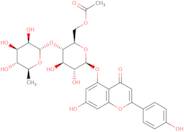
Produktinformation
- 4H-1-Benzopyran-4-one, 5-((6-O-acetyl-4-O-(6-deoxy-alpha-L-mannopyranosyl)-beta-D-glucopyranosyl)oxy)-7-hydroxy-2-(4-hydroxyphenyl)-
- 4H-1-Benzopyran-4-one, 5-[[6-O-acetyl-4-O-(6-deoxy-α-<span class="text-smallcaps">L</smallcap>-mannopyranosyl)-β-<smallcap>D</span>-glucopyranosyl]oxy]-7-hydroxy-2-(4-hydroxyphenyl)-
- 5-[[6-O-Acetyl-4-O-(6-deoxy-α-<span class="text-smallcaps">L</smallcap>-mannopyranosyl)-β-<smallcap>D</span>-glucopyranosyl]oxy]-7-hydroxy-2-(4-hydroxyphenyl)-4H-1-benzopyran-4-one
- 7-hydroxy-2-(4-hydroxyphenyl)-4-oxo-4H-chromen-5-yl 6-O-acetyl-4-O-(6-deoxy-alpha-L-mannopyranosyl)-beta-D-glucopyranoside
Camellianin A is an alkaloid extracted from the plant Camellia oleifera. It has been shown that camellianin A inhibits the growth of cancer cells in vitro and in vivo by inducing apoptosis. This effect is mediated by a caspase-3-dependent pathway and may be due to its ability to scavenge anion radicals. Camellianin A decreases the expression of the protein Mcl-1, which is a key regulator of mitochondrial membrane permeability and thus prevents release of cytochrome c from mitochondria and activation of caspases. Another mechanism for this effect may be the inhibition of histone deacetylase activity, leading to chromatin condensation, DNA fragmentation, and cell death.
Camellianin A has also been shown to have anti-inflammatory properties with inhibitory effects on lipopolysaccharide (LPS) induced production of TNF-α and IL-6 in murine mac
Chemische Eigenschaften
Technische Anfrage zu: 3D-FC74465 Camellianin A
Wenn Sie ein Angebot anfordern oder eine Bestellung aufgeben möchten, legen Sie stattdessen die gewünschten Produkte in Ihren Warenkorb und fordern Sie dann ein Angebot oder eine Bestellung an aus dem Warenkorb. Es ist schneller, billiger und Sie können von den verfügbaren Rabatten und anderen Vorteilen profitieren.





